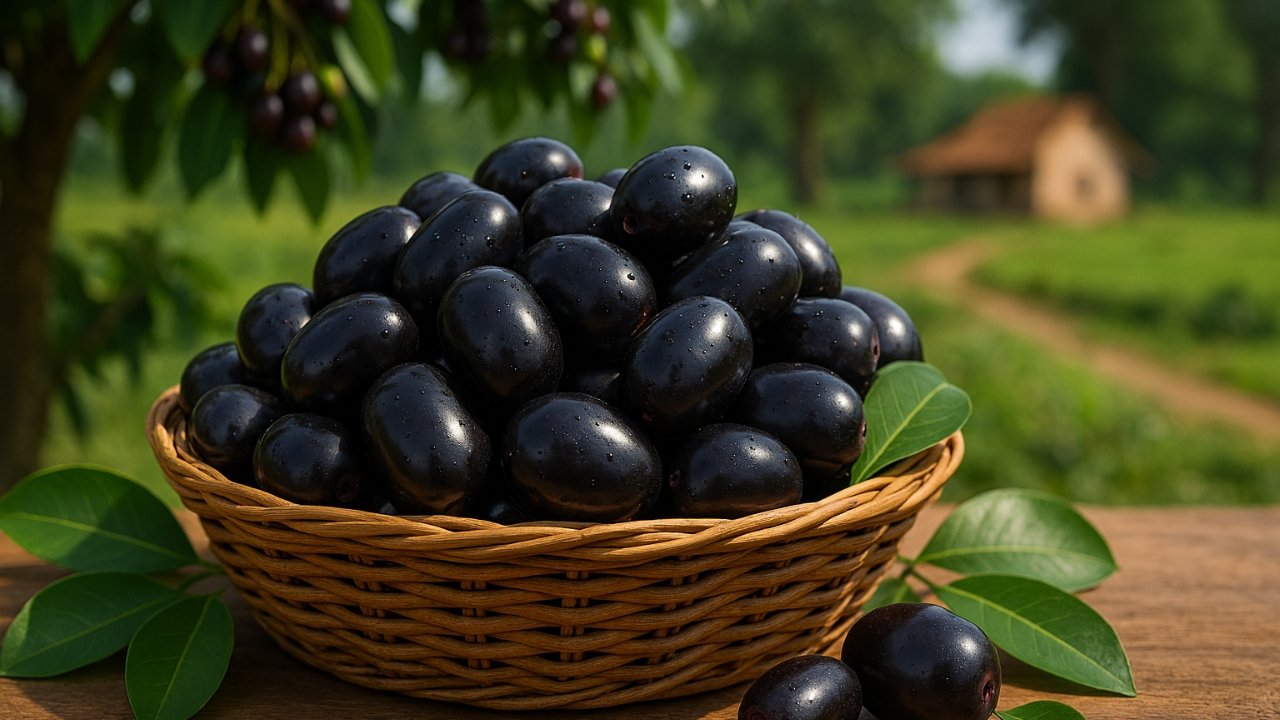Join on WhatsApp
Get the latest updates directly on WhatsApp – motivation, news & more!
India stands as the foremost producer of jamun (Syzygium cumini), a tropical fruit popularly known as Java plum or black plum. With its indigenous origins, deep cultural roots, and medicinal importance, jamun thrives across the Indian subcontinent. Although global production reports often place the fruit under broad “plum” categories, a closer look at its unique cultivation and widespread presence highlights India’s undisputed dominance in growing this fruit. Favorable climate conditions, centuries of traditional use, and its abundance across rural and urban landscapes explain the country’s leadership in jamun production.
A Native Legacy: Jamun’s Stronghold in Indian Agriculture
The jamun tree, an evergreen species native to the Indian subcontinent and Southeast Asia, has been a part of local life for centuries. Beyond its edible fruit, the tree has long been valued for its therapeutic properties and durable timber. Its integration into India’s agricultural and cultural fabric has created a decentralized but extensive cultivation network that escapes typical measurement by agricultural surveys.
The Indian Council of Agricultural Research (ICAR) emphasizes that many jamun trees grow outside formal orchards—in home gardens, community spaces, and along roadsides. This widespread but informal presence means that official statistics often underestimate true production volumes. According to Dr. Priya Singh, plant scientist at the University of Agricultural Sciences, Bengaluru:
“Since most jamun trees are not grown in commercial farms, they remain invisible in agricultural datasets. The actual yield consumed within communities is far greater than what official reports suggest.”
What Makes Jamun Distinct from Other Plums
Understanding the difference between jamun and other plums is key to recognizing India’s unique position. While countries such as China and Romania dominate the production of plums from the Prunus genus (like Japanese and European plums), jamun belongs to an entirely different species.
The fruit is celebrated for its sweet, sour, and astringent taste, and ripens into a deep purple or bluish-black hue. This botanical distinction clarifies why global “plum” rankings, where China takes the lead, do not accurately represent the world’s jamun production.
Why India Leads in Jamun Production
Several interlinked factors account for India’s global leadership in cultivating this fruit:
- Climatic Diversity: Jamun trees adapt remarkably well to tropical and subtropical regions, thriving in soils ranging from fertile loam to waterlogged clay. Once established, they withstand drought conditions, making them reliable across India’s varied agro-ecological zones.
- Cultural and Culinary Value: Jamun is an integral part of Indian summers. Consumed fresh, or processed into juices, vinegar, jams, and even wine, its Ayurvedic significance adds further value. The powdered seeds are traditionally used in managing diabetes, reinforcing its reputation as a “functional food.”
- Decentralized Growth: Unlike fruits cultivated in organized plantations, jamun is typically grown by small farmers and households, scattered across the countryside and urban fringes. This grassroots model sustains a large production volume even without centralized orchards. The leading producing states include Maharashtra, Uttar Pradesh, Tamil Nadu, and Gujarat.
Limited Exports but Expanding Potential
Despite abundant domestic cultivation, jamun has a modest presence in the export market. The fruit is highly perishable and often astringent unless fully ripe, making it difficult to transport and market internationally. A study by the Pakistan Society for Horticultural Science notes that India’s fragmented, non-commercial cultivation patterns limit large-scale exports, with most of the fruit being consumed locally.
Yet, the global perception of jamun is beginning to shift. Branded as a nutrient-rich “superfruit,” it is gaining recognition for its antioxidant and anti-diabetic properties. Agricultural researchers are actively exploring value-added products and post-harvest technologies to extend shelf life, creating possibilities for a stronger export footprint in the future.
Outlook: Jamun’s Future in a Globalized Food Market
The jamun’s story is inseparable from India’s agricultural heritage. While reliable production figures are scarce due to its unconventional cultivation system, expert consensus and field evidence confirm India as the fruit’s leading producer worldwide. With increasing global demand for unique and health-promoting foods, jamun’s cultural heritage, medicinal relevance, and large-scale availability provide India with an opportunity to expand its influence beyond domestic markets.
In essence, jamun is not just a seasonal delicacy but a symbol of India’s agricultural diversity—a fruit deeply rooted in tradition, yet carrying untapped potential for global recognition.


